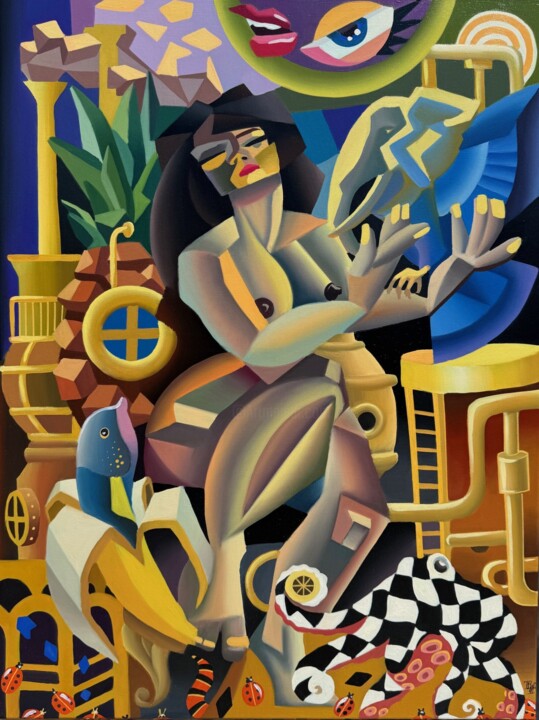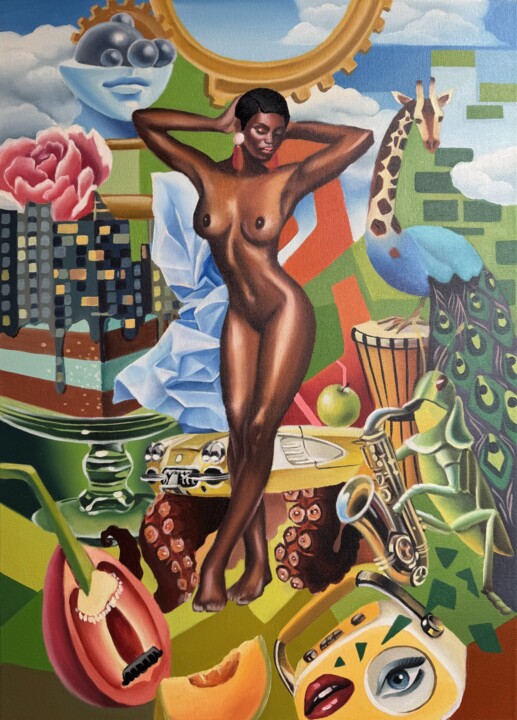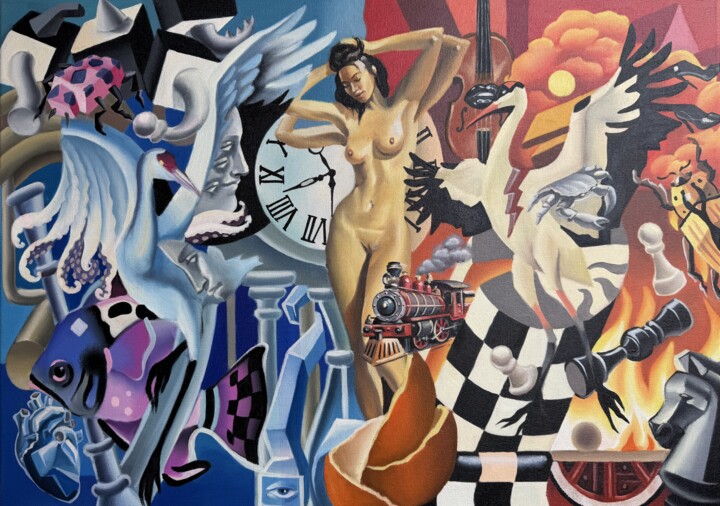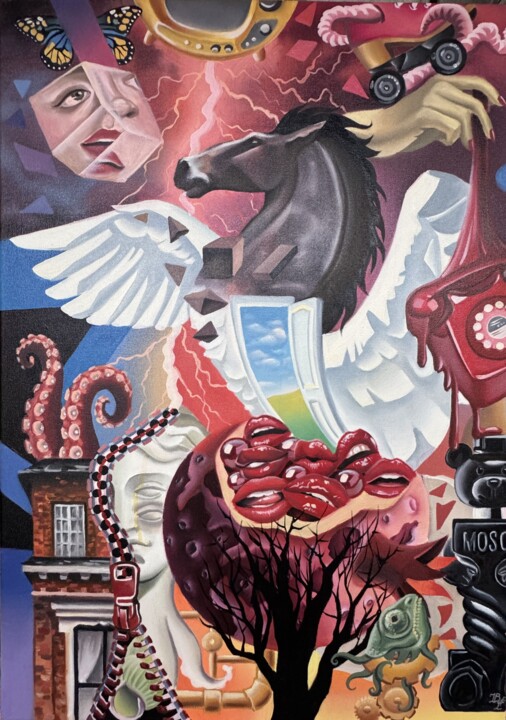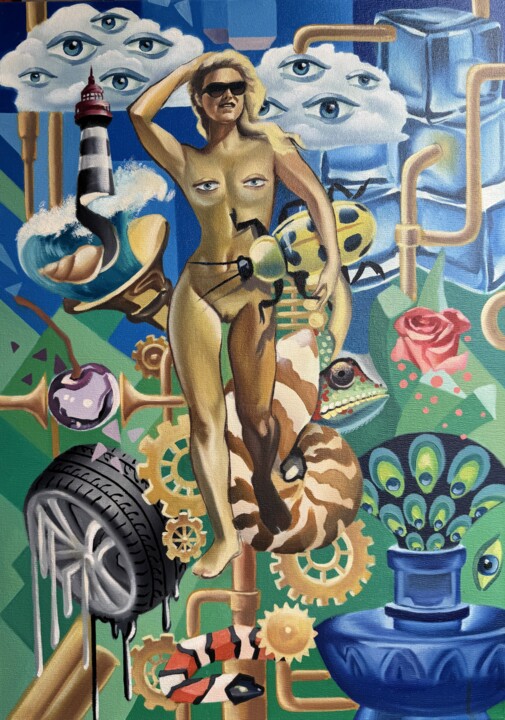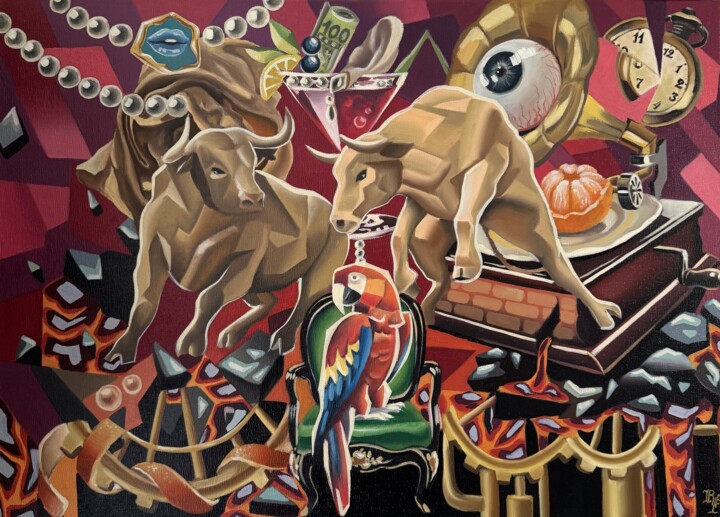What inspired you to create art and become an artist? (events, feelings, experiences...)
It all probably started in childhood, when my parents in the village created some kind of sculptures, or as it is more fashionable to say now "installations" for children from scrap materials, because there were no other entertainments, and we were happy with this manifestation of art, because all this also had to be painted. My older sister sewed dolls for me and painted pictures on the walls in our house, because at that time the wallpaper in the Soviet Union was extremely monotonous, gray and boring! In order to live and feel like human, our common people had to create! In elementary school, my talent and desire to create were noticed, I began to paint the interior spaces of the school... at the request of teachers, and not graffiti, as you would probably think and it was gouache, not spray, and the theme was fairy-tale characters!
Starting from the age of 10, I became interested in redrawing pictures from books, adding my own elements that I thought the author had missed. When coloring, I chose my own colors. Then I decided on my path in life and decided to devote myself to creativity and art. Music school, an attempt to become a fashion designer, art school, competitive ballroom dancing... Couldn't sit still, I participated in competitions, learned new things, studied the history of art. I taught creativity to children.
However, there was a problem, I was very shy this did not allow me to fully express myself. I gave the paintings to relatives and friends. The breakthrough in the awareness of my abilities came later, it connected with a funny story. When I started our art project with my husband, we needed a portfolio, tried to collect at least some works. At that time the house of distant relatives was being sold. There were my paintings inside, so when we asked the new owners of the house to give paintings back, they turned out to be people connected with art, and explained to us that the house was bought mainly because of the collection of paintings, house itself would serve at best as a weekend cottage.
A little later in Europe, at an auction with my husband's friends, we discussed the work of one of the local celebrities, and from that moment my modern story began. I will not talk about that event for ethical reasons, but my experience and knowledge were sufficient to enter a new wonderful life.
What is your artistic background, the techniques and subjects you have experimented with so far?
I think calling my creative path "artistic past" is too "loud", rather it is some life experience, observations of life events, relationships between people, interactions of physical and chemical ordinary objects. The distinction between what is happening "good" and "evil", statements of smart people, contemplation of nature, the birth of a child and creativity for the most beloved creature in the world, and reading books on history and art - these are the ingredients that make up my creativity. And of course, my husband, an infinitely creative person, who thoroughly understands many issues, especially those not covered by official science, made a significant contribution.
To cut the answer short, initially I was drawn to realism, mostly still lifes and landscapes, often visiting crowded places and sketching figures. Then came drawings and industrial graphics. I created designer models of external spaces. In terms of my studies, I was into traditional folk art, for example, Khokhloma wood painting. I did clay modeling. Willow weaving. Collage and folding complex objects out of paper. I still often use all of this when creating toys for children.
At this stage, I have identified three directions in which I like to work: surrealism, based on symbols and signs, cubism, which I like to combine, for example, with a realistic depiction of the body, and the third is silhouettes in various techniques. And also one direction in which I worked before, and which I want to raise to a new level, is non-objective abstractions, perhaps tying them to geometry, and/or minimalism or "children's" creativity with funny characters, in which I also have experience including complex patterns.
What are the 3 aspects that differentiate you from other artists, making your work unique?
To be honest, I have never spied on other people's themes, and I don't know how unique my works are, I did what was inside me and what I wanted to do from the Soul. Perhaps specialists will be able to notice these differences, I don't like to brag or overstate my own achievements, but since the question is exactly like this, then perhaps it is worth indicating what I do well, even by the standards of my strict self-control:
Most surrealist works have a very deep information background, all elements have meanings and symbols are thoroughly worked out. A lot of specialized literature is read, consultations with specialists take place, a narrative structure is built so that the picture can be read in different ways, but believe me, there is a basic version, which I do not voice after one case, but suggest that everyone “read their own story”. You will want to return to “reading” the picture again and again, and each time you will find something new, or simply remain perplexed. So there is a real mystery.
In works using complex relief or strict geometry, a huge amount of work and time is devoted to clarity, symmetry and accuracy of application of materials. I am definitely not one of those who are ready to throw paint on the canvas and smear it, I scrupulously draw details when the work plan requires it. The graphic designer in me, as well as the natural love for ideal order and cleanliness, come into play.
I spent several days in an ancient monastery, improving my skills and gaining experience in creating paints from natural pigments for the restoration of icons, so sometimes my paints that I use are not the simplest, but with secrets. And it is also impossible to deny the presence of energy in painting, so the creation of my works goes through certain rituals and meditations, I do not think that many can boast of this. It is also worth mentioning that in some paintings, with special pigments (based on phosphor, for example), you can see additional mysteries at nightfall or under ultraviolet light.
Perhaps the unique moments also include the mixing of styles, for example surrealism and symbolism with cubism, but without having a complete understanding of the situation in the field of art, I will leave this question open to specialists.
Where does your inspiration come from?
I'm afraid to sound banal, but look at what's going on around us! Life gives us inspiration and themes, you just have to pay attention to this issue, and not chase money and plans! Open your eyes and ears, meditate, reflect, look not only around you, but also inside. Read! Be interested in something new for yourself and there will be no shortage of inspiration and information, and the technique of applying the material will come in handy, although I don't consider it fundamental. The main thing is the idea, the thought! And our life gives it in abundance in all its manifestations, both external and internal! The information surrounding us is a diamond that the artist just needs to turn into a brilliant!
What is your artistic approach? What visions, sensations or feelings do you want to evoke in the viewer?
Since my work is multifaceted, of course the set of creative principles and goals are somewhat different for each direction, and the direction, as a rule, unites artists using the same method, and I am very independent and do not want to go with the flow, but only my own "paths". I do not put myself within the framework of the approach when creating artistic images and depicting phenomena.
The main approach and the same principle is honesty towards yourself! To understand my thought, I always do the work so that if it hangs in the main room of my house and I meet it every day, I will not be ashamed of it.
As for the visions, sensations and feelings that should capture the viewer, each of my directions has its own goals:
- Surrealism calls for thinking, searching, being amazed, finding, deciphering, falling into a stupor, being perplexed, immersing oneself in other worlds, being captured by an event, getting lost in what is happening on the canvas, receiving prophecies and riddles...
- Silhouettes are strict minimalist works based on minimalism, evoking peace, stopping the stormy flow of consciousness with their rationality and simplicity, they evoke a feeling of stability, as if a final seal, especially when made in gold on a deep black background, for example by casting and not smearing paint.
- Naked realistic bodies are designed to give rest to the brain and give pleasure to the eyes, especially the erotic lines of the body highlighted by a sharp, rough cubic background evoke secret dreams and desires, and perhaps serve as a desired ideal for someone, not vulgarized by photography, but painted with a living brush.
A separate topic is contrast and gamut, they are certainly not accidental, but we will already delve into the topics of psychology of color perception and neurophysiological mechanisms of the psyche. Also we will lift the curtain of mystery, which loves silence.
What is the process of creating your works? Spontaneous or with a long preparatory process (technical, inspiration from art classics or other)?
It is impossible to answer this question unequivocally. I always have a list of topics that interest me for more information-rich works, and I always prepare for them thoroughly and in advance, gaining knowledge from literary and video sources. I rarely turn to the classics, but I can, of course, look up some historical or religious topics in the history of art. It is important that I never linger on a painting if I feel a drain of energy, or an inner voice says "not now", so I always have several paintings in progress, and my most important rule is to work only according to my mood, and not out of necessity. This mainly concerns surrealism, where the meaning and importance of details lie.
As for nudes and silhouettes, I live by the sea, and believe me, the themes come spontaneously, and you don't have to go far to model the situation. If the theme is not just entertaining, and the body pose or plot needs to convey information, then of course I often turn to the classics, more often I look into the Renaissance. The main directions of development of modern art are known and understandable to me, of them I turn to Salvador Dali for inspiration, and in Cubism I like modern Apollonas Soben and Georgy Kurasov.
Do you use a particular work technique? if so, can you explain it?
I don't think my technique can surprise anyone or bring anything new to art, everything has been invented long ago. Of course, I have chosen several techniques and many auxiliary tricks for myself, but I admit I am not ready to share them, especially elements of my oil paints. I prefer thin layered work not work with a palette knife, for the depth of color, and if necessary I add volume with shadows.
Are there any innovative aspects in your work? Can you tell us which ones?
As I have already indicated, I use unconventional elements in paints, especially phosphorescent elements and symbols that appear only under certain lighting, for example UV. I have many thoughts about innovations, but I will start experimenting with abstract works after the construction of a new workshop, they are too unconventional for a populated area. Let the intrigue remain, there should be a mystery in a girl ;)
Do you have a format or medium that you are most comfortable with? if yes, why ?
I try not to dwell on the format or medium. I have artworks in the collage and installation style, but most of all I am used to painting with oil on canvas without the use of siccatives and other chemicals, probably the "call of the ancestors" or I am just old-fashioned in this regard. When the work should become a "bright spot" using "electric" colors and sharp scales, and the composition is clear, I can use high-quality Dutch acrylic paints. I often use a lightweight stretcher, because I am a girl... Of course, a revolution in the use of the medium is approaching, but for now it is at the stage of a mystery, even for me.
Where do you produce your works? At home, in a shared workshop or in your own workshop? And in this space, how do you organize your creative work?
I have secluded myself in a dead-end town on a mountain, and the studio has a panoramic view of the sea, which gives me peace, as well as a lot of energy and inspiration. In the summer, I most often work on the terrace, and in the winter next to the fireplace and a large screen above it, to view the necessary information. The back of the house has a garden with direct access to a real forest, and this garden is my refuge on hot summer days, where I can create among flowers and fruits. In the northern part of the house there is a separate room for packing and storing paintings, it is easier to maintain an optimal temperature there, especially in summer.
Does your work lead you to travel to meet new collectors, for fairs or exhibitions? If so, what does it bring you?
I travel quite a lot around Europe, but I must admit not for work, but as part of our family, and I prefer museums to exhibitions and fairs. We are a creative family, and we have long chosen for ourselves a lifestyle in which everyone does what they are professionally able to do, so we think it is right to work more with galleries and auctions, which in turn carry out further activities for the correct sale of the fruits of our creativity. This leaves us with more time to create paintings and for our personal life, this is the most important thing for us - creativity and a narrow family circle, which we jealously preserve, trying not to give much information to the outside world, and to travel not out of necessity, but out of desire.
How do you imagine the evolution of your work and your career as an artist in the future?
I really want to try myself in real impulsive abstractionism to give full vent to emotions, to create a work of art without limiting myself to anything, and this is not in a figurative sense, but in a direct sense - completely submit to the elements of inspiration and fantasy. If it will be necessary not only to fill the entire room with paint, but also to destroy everything around, burn, chop, shoot, scream, dance wildly or sleep on the painting... there are many more fantasies than I can describe here censoredly. So, for these needs, the construction of a separate room is planned, further from civilization, and a plot of land has already been purchased.
What is the theme, style or technique of your latest artistic production?
A finished and drying oil painting on the theme of Africa, in the style of surrealism, extremely saturated with shades of red, with a large number of geometric elements (square, grid, cage) and, as always, symbols and signs. I hope that soon it will be in the offer on Artmajeur. In the process of finishing a cubic painting with a marine theme (fish, mermaid) I am doing it with acrylic for speed. In the style of silhouettes, a “couple in love” in gold and silver on a very complex (with a secret) red background is almost ready.
Can you tell us about your most important exhibition experience?
This was probably my very first exhibition in Europe, in Pilsen, Czech Republic, at the Alšovka gallery. I experimented with silhouettes and was very shy about the results. There were famous artists at the exhibition, and I was a foreigner, with such a strange collection, not typical of national habits. The size of the paintings was small, the style was minimalistic, and it seemed to me that I had not invested enough time in their creation. But the relaxed atmosphere and format of the exhibition, my family nearby, friendly hosts and grateful guests, practically turned my attitude towards the situation around me upside down. However, as an introvert, I still like creating paintings in the comfort of my home atmosphere more than the process of presenting them to the world.
If you could have created a famous work in the history of art, which one would you choose? And why ?
Oddly enough, even without any special plans for fame, I am planning a work on a format close to two meters, in the style of more realistic surrealism. Where many troubles gnawing at our modern world will be written, like on frescoes of biblical themes, there will be ecology, social inequality, conflicts, violence, bad habits, addictions, corruption, worship of wealth, exploitation, destruction of flora and fauna, merciless torment of the earth's surface, man-made disasters, lies, formation of mass consciousness and much more. In fact, I believe that humanity is madly running along the razor's edge, and it's high time to change everything, and the next generations will need to learn about these events. Although I cannot compete with Albrecht Durer, Hieronymus Bosch and Karl Bryullov, no one will forbid me to try!
If you could invite one famous artist (dead or alive) to dinner, who would it be? How would you suggest he spend the evening?
Through this interview I would like to address the artist who is moving full speed towards fame! “Apollonas Soben, let’s put aside our canvases and brushes for at least one day, turn off our phones and computers, forget about the yacht and other things, and just light a fireplace, take our favorite sweets and tea, cover ourselves with a blanket and lie around all day chatting about nonsense or just silently, together, hide from the world, be only for ourselves, make this wonderful moment of our life freeze for this day!”







 Olimpia Gaia Martinelli
Olimpia Gaia Martinelli



